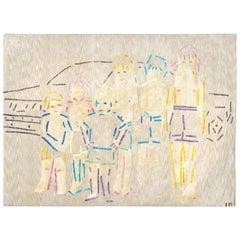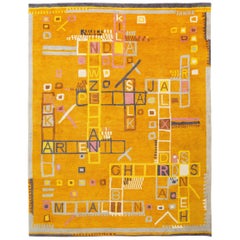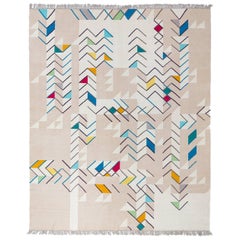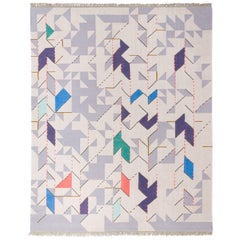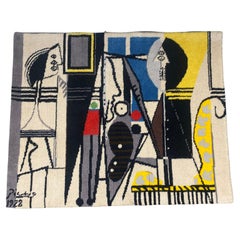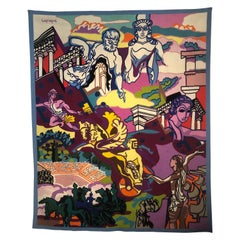Johanna Boccardo Rugs and Carpets
4
to
4
4
1
1
4
Width
to
Length
to
4
4
4
4
4
20
5,331
4,001
1,428
1,227
Creator: Johanna Boccardo
Limited Edition Handwoven Tapestry/Rug by Miami Beach Artist, Johanna Boccardo
By Johanna Boccardo
Located in Mexico City, MX
Through a process of graphic synthesis that simplifies, unifies and makes independent the subjects of a family photo, and after reviewing the cultural and genetic diversity of the Ve...
Category
2010s Indian Johanna Boccardo Rugs and Carpets
Materials
Wool
Gabbeh Knot Rug "Silk Road" by Johanna Boccardo, Limited Edition
By Odabashian Rugs, Johanna Boccardo
Located in Mexico City, MX
This Gabbeh Knot rug is a limited edition of ten art rugs, woven by Odabashian's network of family-owned weavers near Mirzapur, India with the finest New Zealand wool. The design for...
Category
2010s Indian Post-Modern Johanna Boccardo Rugs and Carpets
Materials
Wool
"Thing 1" Kilim Rug, Open Edition Super-Fine New Zealand Wool Yarn with Fringes
By Johanna Boccardo
Located in Mexico City, MX
This is an open edition Kilim rug, woven by Odabashian's network of family-owned weavers near Mirzapur, India with the finest New Zealand wool. The design was created by Miami based ...
Category
2010s Indian Post-Modern Johanna Boccardo Rugs and Carpets
Materials
Wool
Kilim Rug Super-Fine New Zealand Wool Yarn with Fringes "Thing 2", Open Edition
By Johanna Boccardo
Located in Mexico City, MX
This is an open edition Kilim rug in the finest New Zealand wool, woven by Odabashian's network of family-owned weavers near Mirzapur, India. The design was created by Miami based ar...
Category
2010s Indian Post-Modern Johanna Boccardo Rugs and Carpets
Materials
Wool
Related Items
Picasso Limited Edition Artist Rug/Wall hanging by Desso, Netherlands, 1996
By Desso, (after) Pablo Picasso
Located in Buffalo, NY
Picasso limited edition artist rug or Wall hanging by Desso, Netherlands 1996
Based on the work of Pablo Picasso entitled "Le peintre et son...
Category
1990s Dutch Folk Art Johanna Boccardo Rugs and Carpets
Materials
Wool
French Artist Charles Lapicque Tapestry Limited Edition 1/2 "Pelops", 1964
By Charles Lapicque
Located in Paris, France
Exceptional limited edition 1/2 tapestry "Pelops" with certificate from a private collection,
1964.
Ateliers Pinton brothers in Felletin, under the supervision of Pierre Baudouin
2ex + 1EA Editor Aram Iynedjian. The tapestry will be sold with its certificate of authenticity from the gallery.
From the 15th century, the name of Pinton was associated with the Aubusson tapestry. Since then, over the generations, the Pinton family has largely contributed to the development of this fabulous cultural heritage until the creation in the 19th century, of the Felletin factory, in the department of Creuse. Even today, in these workshops, the craftsmen execute the same correct gestures with the same attention to detail and thus extend the chain of the history of the tapestry of tradition but also contemporary. The hand of specialists, the eye of designers and dyers and the taste of the most demanding clientele find their meaning in the fabric of the carpets. The excellence of French know-how, a living heritage society and custodian of Aubusson's cultural heritage, has always collaborated with great artists. The works of Charles Le Brun, Charles Lapicque, Pablo Picasso, Jean-Michel Othoniel, and many other big names in the world of painting, architecture, design, fell into the looms and know-how ancestral of this unique Creuse creator.
Editor Aram Iynedjian
Aram Iynedjian, Lausanne gallery owner and editor of tapestries from Braque, Estève and Lapicque, the latter meets Pierre Baudouin, the most famous of the cardboard painters of the time. The one who translated the works of Le Corbusier, Calder or Picasso into tapestry then collaborates with Charles Lapicque and they will develop a work of great richness.
Lapicque came to realize these two summits which are "Pélops" and "Diane et Actéon".
I realize that you should never try to describe a work of art
Let’s look at it. Let us admire the science of composition, linear purity, technical perfection, the beauty of color, the truth of the drama. Let us see, if we can, the implacable presence of genius.
"We will now understand that after having based a painting on the love of tapestry, it was relatively easy, and very tempting, to build a tapestry faithful to my painting," explained the artist in the exhibition catalog. of the Galerie Verrière in 1970. It was not until 1961 that he began to produce cardboards both for the tapestry of the Lisse in Aubusson, but also at the Mobilier National, with the help of Pierre Baudouin
Charles Lapicque (1898-1988)
Born in 1898 in Theizé (Rhône) in a family practicing both the arts and the sciences, Charles Lapicque is no exception to the rule: gifted for music and drawing, he graduated from the École Centrale in 1921, works as engineer until 1928 before integrating in 1931 a laboratory at the Faculty of Sciences of Paris, where he carried out research on the perception of colors, crowned by the title of Doctor of Physical Sciences in 1938. He thus studies the reactions of the eye in front of an intense light source, at the origin of the formation of starry images which he will use in his works, and defines a theory of the staggering of colors in space which overturns the rules of the Renaissance: "I had shown that the Classic rule, that of Vinci, advocating placing the blues in the distance, the reds, oranges and yellows in the foreground, is
a nonsense; it makes more sense, more favorable to do the opposite. "(In Red and blue in the arts, 1936)
It was around 1920 that Charles Lapicque began to paint in Brittany where he spent every summer since his childhood, first on the motif and then in a workshop that his stepfather Jean Perrin, Nobel Prize in Physics, had him build in 1927 ; he then definitively adopted the work of memory, in accordance with the art of music which he deeply loved and the Bergsonian philosophy of knowledge: "It is up to us to give reality an appearance that it has no itself, a form, a figure (...). "
His youthful production immediately reveals a great originality, oscillating between figuration and abstraction which sometimes intertwine: alongside synthetic paintings by their simplified drawing and their flat colors, he designs an Homage to Palestrina (1925), composed of a grid derived from Cubism, entirely abstract, relayed by a Christ with Thorns (1939), according to a principle that he will develop after 1939, in line with his optical discoveries. In fact, during the war years, an almost abstract period began, that of the tight blue framework, applied to backgrounds ranging from yellow to red and revealing a more or less identifiable world (Jeanne d'Arc crossing the Loire, 1940; Rencontres series, 1940-1945). Exhibited in 1929 by the gallery owner Jeanne Bucher, Lapicque abandoned his scientific career in 1943 to devote himself entirely to painting.
He continued his work which resulted in 1946-1953 in white-frame structures; their much softer lines lead him to the system of
either black or white interlacing which encloses areas of pure color, most often in solid color. With The Battle of Waterloo in 1949, Lapicque still uses optics - zooming in on a given area - to depict spaces with multiple perspectives and decomposed times.
This new interest in the liveliness of color developed in the following period, which can be described as flamboyant or Baroque (1954-1963): illustrated in particular by the series of Breton lagoons and twilight or nocturnal views of Venice in the light. Stars, which the artist himself describes as “daring sweets”, it begins with the Raoul Dufy Prize of the Venice Biennale, awarded in 1953 to the artist who took the opportunity to give free rein to his passion for the Serenissima until July 1956.
Another point in common with his elder brother is the expression of movement. Begun in 1949 in The Battle of Waterloo then in 1952 with Dimanche aux regates, it became an obsession from 1964, in the exploration of new themes, such as the different shots of tennis players captured on the fly (1965), the mythological scenes and sea storms.
These dizzying years precede the artist's last period: as he comes of age, he discovers serenity, revealed by a painting now with acrylic paint, much more peaceful from 1974, which even borders on a childish naivety at the end. of his life.
All of his work includes an astonishing diversity of themes, also nourished by his travels (Rome in 1957, Greece in 1964, Holland in 1974 ...), with a predilection for the sea, rocks, sailboats, music, tennis, horses, wild beasts, but also for history and mythology, as evidenced by knights, kings and ancient gods. It also deploys, in total creative freedom, a wide variety of styles and orientations. Having been one of the pioneers of non-figurative art, thus paving the way for artists like Manessier, Bazaine, Vieira da Silva, De Staël, etc. Owners of the new non-figurative Paris School of the Postwar period, Charles Lapicque then returned to figuration, in a "new interpretation" of appearance, even if he continued to rub shoulders with abstraction at times.
"Drawing runs after color and color after drawing. "
Heir to the Fauves, Charles Lapicque plays like them on pure colors, whose dissonances, associated with a totally free design and an overloaded composition in a multiple space, make him a precursor of the New Figuration in all its forms: the Narrative Figuration born in France in the early 1960s, represented in particular by Gérard Fromanger, Erró, Bernard Rancillac and Gérard Guyomard; Free Figuration born in the early 1980s, marked by Robert Combas, Hervé and Richard Di Rosa, Louis Jammes and François Boisrond, and which, in turn, influenced the American Bad Painting of a Jean-Michel Basquiat or a Keith Haring, deliberately neglected and Expressionist; Lapicque's “Classic subjects” were able to feed Cultivated Painting, which also appeared in the early 1980s with Jean-Michel Alberola, Patrice Giorda and Gérard Garouste...
Category
Mid-20th Century European Johanna Boccardo Rugs and Carpets
Materials
Wool
H 86.62 in W 104.34 in D 0.2 in
Vintage Tapestry Rug French Style Carpet Dancing Scene Handmade Tapestry
Located in Hampshire, GB
Beautiful dancing scene French-style tapestry was handmade in China and features five figures dancing in what looks like the forest of a castle. Muted greens, browns and yellows have been used to weave this realistic Tapestry.
This high-quality Vintage tapestry is perfect for both modern and traditional interiors suitable for use as a kitchen rug, bedroom rug or living room rug. Lighten any room you introduce it too.
Handwoven with the finest handspun cotton and wool, dyed using organic vegetable dyes, in 1970.
Vintage tapestry rug...
Category
Late 20th Century Chinese French Provincial Johanna Boccardo Rugs and Carpets
Materials
Wool, Cotton, Organic Material
H 57.88 in W 91.34 in D 0.79 in
White/Blue Handwoven Tapestry by Calyah
Located in Geneve, CH
White/Blue handwoven tapestry by Calyah
Unique piece
Materials: Tibetan wool and silk.
Dimensions: 170 x 65 x 1 cm
Colour: white/blue
Also available in red/yellow, gold/orange, ...
Category
2010s Nepalese Post-Modern Johanna Boccardo Rugs and Carpets
Materials
Wool, Silk
Tapestry No.01 by Cappelen Dimyr
Located in Geneve, CH
Tapestry no.01 by Cappelen Dimyr
Dimensions: D120 x H140 cm
Materials: 85% wool 15% cotton
Tapestry no.01 is made from chunky natural white shaded ...
Category
2010s Danish Post-Modern Johanna Boccardo Rugs and Carpets
Materials
Wool, Cotton
Rare Tapestry Rug Wall Hanging Carpet, Rugs French Aubusson, Garden Sence
Located in Hampshire, GB
A fabulous 19th-century handwoven tapestry in excellent condition. The scene of celebration among nature. A similar technique is used for making the tapestry, as in Aubusson and Needlepoint in the flat weave role. These decorative area rugs are sporadic luxury rugs for sale in any rug store. They can exist as designer rugs or interior design elements in antique rug galleries or be recommended as a design object by interior designers for home decor.
Rare Tapestry Rug Wall Hanging Carpet...
Category
19th Century French Baroque Antique Johanna Boccardo Rugs and Carpets
Materials
Wool, Cotton, Organic Material
H 70.08 in W 66.54 in D 0.4 in
Handwoven Rug / Tapestry by Cepelia, Poland
Located in Kansas City, MO
Handwoven tapestry / rug designed by Rumiany Sznajder for Cepelia, Poland, 1970s. The condition is excellent with no signs that this has ever been used as a rug. Beautiful colors of ...
Category
1970s Polish Mid-Century Modern Vintage Johanna Boccardo Rugs and Carpets
Materials
Wool
Antique French Tapestry Handmade Tapestry Large Verdure Tapestry 5x9
Located in New York, NY
Antique Tapestry French Figural Tapestry Verdure Battle
5' x 8'10" (5' x 9')
152cm x 269cm
Circa 1900
"This is an Rare Antique French Aubusson Tapestry with monogram signat...
Category
Early 1900s French French Provincial Antique Johanna Boccardo Rugs and Carpets
Materials
Wool
H 105.91 in W 59.85 in D 0.48 in
Tapestry by Nathalie du Pasquier, Limited Edition, No. 2/36, Signed 2005
By Post Design, Nathalie du Pasquier
Located in Kansas City, MO
Tapestry by Nathalie du Pasquier for Post Design, Italy, 2005. This example is number 2 of 36. This thick handwoven wool wall hanging is in excellent condition.
Category
Early 2000s Italian Post-Modern Johanna Boccardo Rugs and Carpets
Materials
Wool
Grau Garriga Limited Edition Tapestry, 1975
Located in Barcelona, Barcelona
Limited edition tapestry by the Spanish textile artist Grau Garriga, circa 1975.
Artwork number 290/500.
In original condition with minor wear cons...
Category
1970s Spanish Mid-Century Modern Vintage Johanna Boccardo Rugs and Carpets
Materials
Textile, Wood
1870 Antique French Tapestry Wool & Silk Tapestry Beige Handmade Tapestry
Located in New York, NY
Amazing Rare Antique French Tapestry Fine Wool & Silk
Beige
5'2" x 8"
158cm x249cm
Circa 1870
"This is a very fine Authentic Antique French Tapestry in Wool & Silk....
Category
1870s French Antique Johanna Boccardo Rugs and Carpets
Materials
Silk
H 98.04 in W 62.21 in D 0.48 in
French Inspired Lorraine Rug Hand Knotted with Bamboo Silk and New Zealand Wool
By Casa Botelho
Located in London, GB
Artwork for the floor, rugs have always been a home accessory that João has adored. While travelling through a small town in the Lorraine region of France, Thaon-les-Vosges, João became fascinated with what the French call, ‘Tuile de façade’; the use of embossed metal tiles on the walls and ceiling. With a desire to introduce this exquisite accessory into the homes of those around the world, João approached Jennifer Manners...
Category
21st Century and Contemporary Indian Johanna Boccardo Rugs and Carpets
Materials
Wool, Silk
W 70.87 in L 94.49 in
Johanna Boccardo rugs and carpets for sale on 1stDibs.
Johanna Boccardo rugs and carpets are available for sale on 1stDibs. These distinctive items are frequently made of wool and are designed with extraordinary care. There are many options to choose from in our collection of Johanna Boccardo rugs and carpets, although beige editions of this piece are particularly popular. If you’re looking for additional options, many customers also consider rugs and carpets by Joe Doucet, and Odabashian Rugs. Prices for Johanna Boccardo rugs and carpets can differ depending upon size, time period and other attributes — on 1stDibs, these items begin at $2,600 and can go as high as $5,000, while a piece like these, on average, fetch $2,800.
